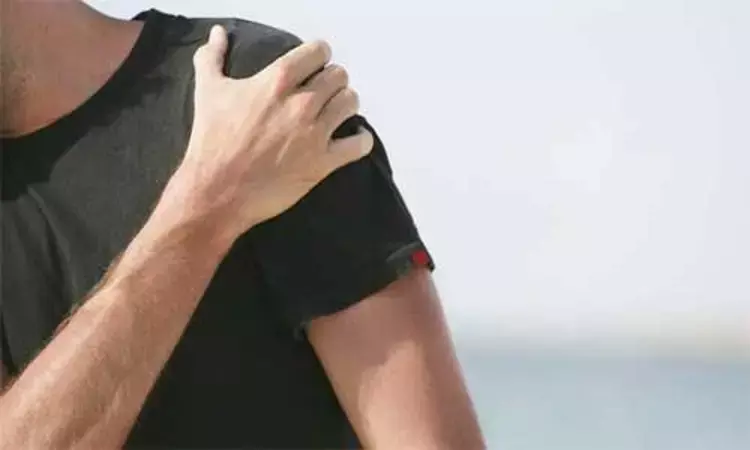- Home
- Medical news & Guidelines
- Anesthesiology
- Cardiology and CTVS
- Critical Care
- Dentistry
- Dermatology
- Diabetes and Endocrinology
- ENT
- Gastroenterology
- Medicine
- Nephrology
- Neurology
- Obstretics-Gynaecology
- Oncology
- Ophthalmology
- Orthopaedics
- Pediatrics-Neonatology
- Psychiatry
- Pulmonology
- Radiology
- Surgery
- Urology
- Laboratory Medicine
- Diet
- Nursing
- Paramedical
- Physiotherapy
- Health news
- Fact Check
- Bone Health Fact Check
- Brain Health Fact Check
- Cancer Related Fact Check
- Child Care Fact Check
- Dental and oral health fact check
- Diabetes and metabolic health fact check
- Diet and Nutrition Fact Check
- Eye and ENT Care Fact Check
- Fitness fact check
- Gut health fact check
- Heart health fact check
- Kidney health fact check
- Medical education fact check
- Men's health fact check
- Respiratory fact check
- Skin and hair care fact check
- Vaccine and Immunization fact check
- Women's health fact check
- AYUSH
- State News
- Andaman and Nicobar Islands
- Andhra Pradesh
- Arunachal Pradesh
- Assam
- Bihar
- Chandigarh
- Chattisgarh
- Dadra and Nagar Haveli
- Daman and Diu
- Delhi
- Goa
- Gujarat
- Haryana
- Himachal Pradesh
- Jammu & Kashmir
- Jharkhand
- Karnataka
- Kerala
- Ladakh
- Lakshadweep
- Madhya Pradesh
- Maharashtra
- Manipur
- Meghalaya
- Mizoram
- Nagaland
- Odisha
- Puducherry
- Punjab
- Rajasthan
- Sikkim
- Tamil Nadu
- Telangana
- Tripura
- Uttar Pradesh
- Uttrakhand
- West Bengal
- Medical Education
- Industry
Shoulder stabilization surgery may lead to arthritis within period of seven years: Study

Findings may help guide clinical decision-making and chronicity of treatment for patients presenting with posterior shoulder instability.
Nashville, Tenn: Patients who underwent shoulder stabilization surgery experience glenohumeral (shoulder joint) arthritis within a period of seven years, reveal results from a recent study.
The findings of the study were presented at the American Orthopedic Society for Sports Medicine-Arthroscopy Association of North America Combined 2021 Annual Meeting.
"While arthroscopic stabilization for posterior glenohumeral instability has shown excellent success preventing recurrent instability and allowing return to sport, eventual progression to glenohumeral arthritis remains a concern in these patients," said Bobby Yow, MD, of Walter Reed National Military Medical Center, Bethesda, Md. Yow and colleagues sought to evaluate the rate of progression to glenohumeral arthritis and identify potential risk factors after arthroscopic posterior stabilization in a young and high-demand population.
Yow and fellow researchers enrolled 110 patients who were active-duty servicemembers identified in the Military Heath System (MHS) with posterior shoulder instability who underwent primary arthroscopic surgical stabilization and had postoperative imaging or medical records available over a twelve-year period between January 2004 and September 2016.
Among the 110 patients with posterior shoulder instability that underwent arthroscopic stabilization, 12.7% (14/110) developed glenohumeral arthritis. The mean age of all patients was 23.9 years (SD 6.71). The median time to diagnosis of arthritis was seven years and the median follow-up time was 8.1 years (IQR 5.8). Among all diagnosed with posterior shoulder instability requiring surgical fixation, 12.7% (14/110) developed glenohumeral arthritis during the study period. The overall incidence of GH arthritis was 1.7 per 100 person-years (95% CI 0.92, 2.81). Ten-year GHOA-free survival was 84.0% (95% CI 75.3, 93.8). Hazard ratios (95% CIs) estimated from separate Cox regression models of the development of glenohumeral arthritis were 1.45 (0.76, 2.74) or age in years (per SD) and 0.87 (0.74 to 1.03) for glenoid bone loss.
"No previous study has reported the incidence and risk factors for glenohumeral arthritis after arthroscopic surgical stabilization for posterior shoulder instability," Yow reported. "Though no risk factors were found amongst the cohort, the hypothesized higher risk with increasing age at index procedure and near significant confidence interval for glenoid bone loss warrants further evaluation in larger cohorts not limited to active-duty service members."
Yow said that their findings may help guide clinical decision making and chronicity of treatment for patients presenting with posterior shoulder instability.
Hina Zahid Joined Medical Dialogue in 2017 with a passion to work as a Reporter. She coordinates with various national and international journals and association and covers all the stories related to Medical guidelines, Medical Journals, rare medical surgeries as well as all the updates in the medical field. Email: editorial@medicaldialogues.in. Contact no. 011-43720751
Dr Kamal Kant Kohli-MBBS, DTCD- a chest specialist with more than 30 years of practice and a flair for writing clinical articles, Dr Kamal Kant Kohli joined Medical Dialogues as a Chief Editor of Medical News. Besides writing articles, as an editor, he proofreads and verifies all the medical content published on Medical Dialogues including those coming from journals, studies,medical conferences,guidelines etc. Email: drkohli@medicaldialogues.in. Contact no. 011-43720751


